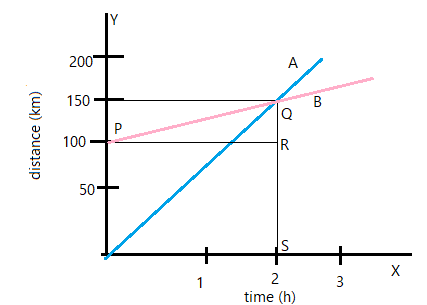Answer
409.5k+ views
Hint: We know that speed is defined as the rate at which distance varies with respect to time. Clearly, function of distance and time. Or speed depends directly on the parameters distance and time. Using this idea, we can solve this sum.
Formula used: speed=$\dfrac{\text{distance}}{\text{time}}$
Complete step by step answer:
Clearly, from the definition, speed depends on the ratio of the two. Here we have a graph between the distance and time of two moving objects A and B. Then the slope of this given graph gives the speed of moving objects A and B.
i) From the graph, when $t=0$ , $A$ is at $100\;km$ and $B$ is at $0\;km$. Then we can say that $A$ is ahead of $B$ by $100\;km$ .
ii) From the graph, we can say that $B$ covers $150\;km$ in $2\;hr$ then the speed of $B$ is given as $v_{B}=\dfrac{150}{2}=75km/hr$
iii) Since at $Q$ the graph of $A$ and $B$ intersects, we can then say that, at $t=2hr$ and at $d=150km$ $A$ and $B$ meet.
iv) From ii) $v_{B}=75km/hr$
Similarly, from triangle $P\;Q\;R$ we can say that $v_{A}=\dfrac{150-100}{2}=\dfrac{50}{2}=25km/hr$
Then the difference between, $v_{B}-v_{A}=75-25=50km/h$
Note: This is a very easy sum. One needs to understand the graph to solve this sum. Also note that the $speed=\dfrac{distance}{time}$, since the given graph is distance-time graph, we can say that the solve of the graph gives the speed of the objects. This is used to solve the questions ii) and iv). Also, note that the steeper the graph, implies more the speed of the body. Here, clearly object B has more speed or is faster than that of A. Since A started at $100\;km$, it is quite clear that the speed of B must be greater than that of A, only then B can catch up with A.
Formula used: speed=$\dfrac{\text{distance}}{\text{time}}$
Complete step by step answer:
Clearly, from the definition, speed depends on the ratio of the two. Here we have a graph between the distance and time of two moving objects A and B. Then the slope of this given graph gives the speed of moving objects A and B.
i) From the graph, when $t=0$ , $A$ is at $100\;km$ and $B$ is at $0\;km$. Then we can say that $A$ is ahead of $B$ by $100\;km$ .
ii) From the graph, we can say that $B$ covers $150\;km$ in $2\;hr$ then the speed of $B$ is given as $v_{B}=\dfrac{150}{2}=75km/hr$
iii) Since at $Q$ the graph of $A$ and $B$ intersects, we can then say that, at $t=2hr$ and at $d=150km$ $A$ and $B$ meet.
iv) From ii) $v_{B}=75km/hr$
Similarly, from triangle $P\;Q\;R$ we can say that $v_{A}=\dfrac{150-100}{2}=\dfrac{50}{2}=25km/hr$
Then the difference between, $v_{B}-v_{A}=75-25=50km/h$
Note: This is a very easy sum. One needs to understand the graph to solve this sum. Also note that the $speed=\dfrac{distance}{time}$, since the given graph is distance-time graph, we can say that the solve of the graph gives the speed of the objects. This is used to solve the questions ii) and iv). Also, note that the steeper the graph, implies more the speed of the body. Here, clearly object B has more speed or is faster than that of A. Since A started at $100\;km$, it is quite clear that the speed of B must be greater than that of A, only then B can catch up with A.
Recently Updated Pages
In a flask the weight ratio of CH4g and SO2g at 298 class 11 chemistry CBSE

In a flask colourless N2O4 is in equilibrium with brown class 11 chemistry CBSE

In a first order reaction the concentration of the class 11 chemistry CBSE

In a first order reaction the concentration of the class 11 chemistry CBSE

In a fermentation tank molasses solution is mixed with class 11 chemistry CBSE

In a face centred cubic unit cell what is the volume class 11 chemistry CBSE

Trending doubts
Which are the Top 10 Largest Countries of the World?

Difference Between Plant Cell and Animal Cell

Give 10 examples for herbs , shrubs , climbers , creepers

Fill the blanks with the suitable prepositions 1 The class 9 english CBSE

Write a letter to the principal requesting him to grant class 10 english CBSE

Difference between Prokaryotic cell and Eukaryotic class 11 biology CBSE

What is the full form of AD a After death b Anno domini class 6 social science CBSE

Change the following sentences into negative and interrogative class 10 english CBSE

Name 10 Living and Non living things class 9 biology CBSE




